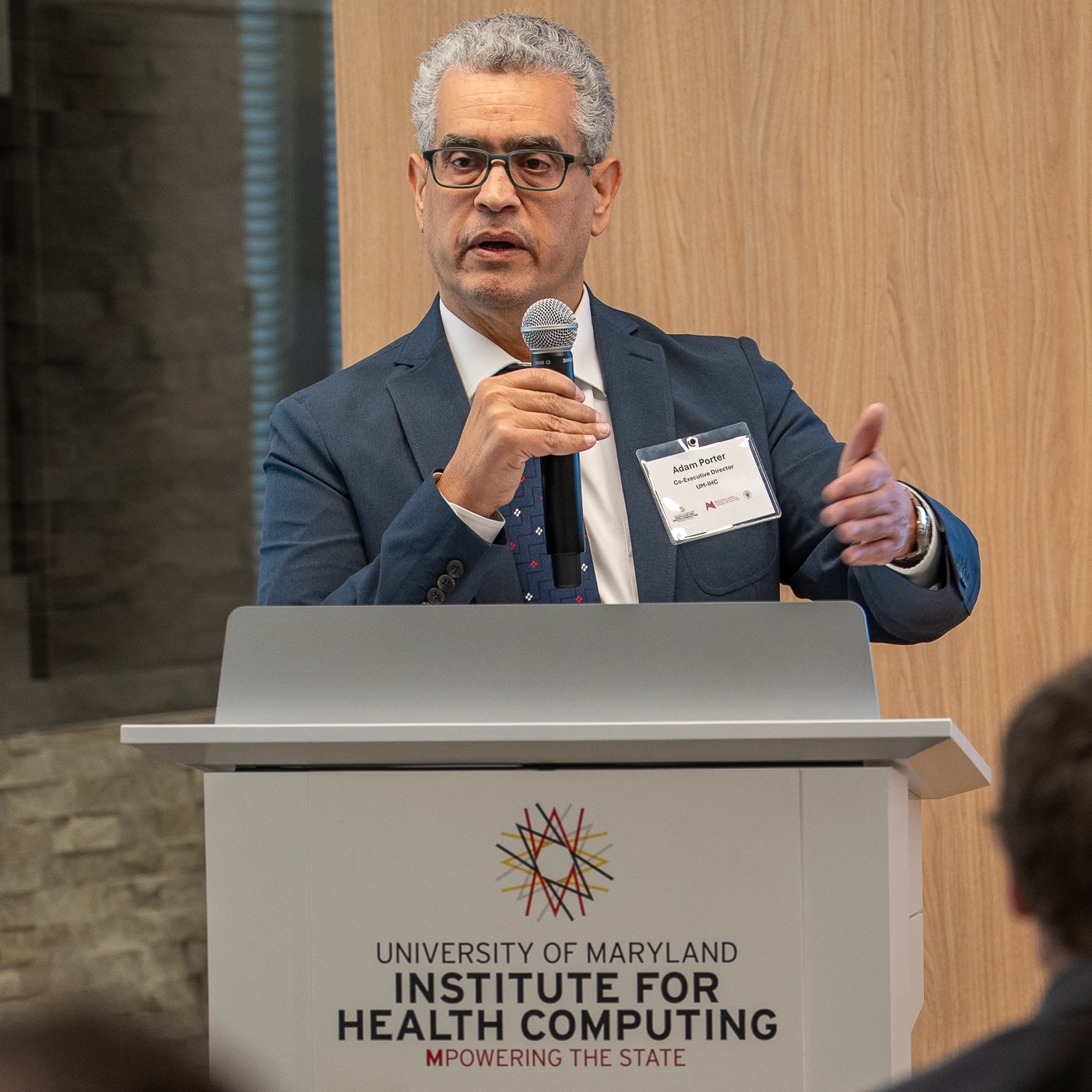
At the University of Maryland Institute for Health Computing (IHC), medical researchers, clinicians, mathematicians, and computational and physical scientists are working together across campuses to tackle urgent medical challenges with advanced technologies.
Teams are using ultra-large-scale machine learning to analyze vast quantities of medical imaging and genomics data for signs of Alzheimer’s disease. Others are developing predictive AI models that can alert surgeons one minute before a patient experiences a potentially fatal heart rhythm anomaly. Another group is inventing personalized therapy recommenders for patients with a rare disease by matching cell profiles with the known characteristics of various available treatments. All of these efforts are designed to save lives, reduce costs, and reshape clinical practice.
Based in North Bethesda and founded in November 2022, IHC brings together expertise from the University of Maryland, College Park; the University of Maryland, Baltimore; and the University of Maryland Medical System. Supported by Montgomery County, the MPowering the State initiative, and the state of Maryland, the institute serves as a central hub for health computing innovation in the region.
 Adam Porter, a professor of computer science at the University of Maryland, College Park, stepped into the role of co-executive director one year ago, joining Dr. Bradley Maron, senior associate dean for precision medicine at the University of Maryland School of Medicine, and Warren D’Souza, senior vice president and chief innovation officer at the University of Marland Medical System, in leading the institute’s rapid growth and ambitious mission.
Adam Porter, a professor of computer science at the University of Maryland, College Park, stepped into the role of co-executive director one year ago, joining Dr. Bradley Maron, senior associate dean for precision medicine at the University of Maryland School of Medicine, and Warren D’Souza, senior vice president and chief innovation officer at the University of Marland Medical System, in leading the institute’s rapid growth and ambitious mission.
For Porter, the dual goals of scientific advancement and economic development are inseparable.
“We’re not just trying to push the boundaries of research,” says Porter who also has an appointment in the University of Maryland Institute for Advanced Computer Studies. “We’re here to help our local companies grow, to deliver real impact for both patients and the regional economy.”
He sharpened that focus during his decade as director of the Fraunhofer USA Center Mid-Atlantic, an applied research center affiliated with UMD, where he worked closely with industry partners to translate academic research into real-world solutions. There, he shifted from leading with technology to leading with need—focusing less on promoting specific research interests and more on understanding what companies were struggling with. That meant learning the language of business, building relationships, and identifying where his team’s expertise could deliver real value, all lessons that he brings to his role as co-director of IHC.
“One of the most important lessons I learned is to lead with empathy,” Porter says. “You can’t assume people need your research. You must understand their problems first—then figure out how your work can help solve them.”
At IHC, he has helped shape what he calls a “collision space”—a place where clinicians, biologists, engineers and computer scientists come together to tackle complex problems. The institute now includes more than 130 participants from its founding institutions and federal agency partners, and its research agenda is expanding rapidly.
One of Porter’s priorities is to establish IHC as a national leader in building and validating AI models for health care.
“We’re creating infrastructure and partnerships to help companies evaluate their models quickly and safely,” he explains. “We’re also working on accelerating therapeutic discovery and using real-world evidence to improve clinical trials.”
That vision is backed by major investments: the institute is finalizing the purchase of a multi-million-dollar advanced computing infrastructure, supported in part by a $3 million federal earmark. It’s also helping to support a new life sciences innovation district near the North Bethesda Metro Station, part of a broader strategy to grow Maryland’s health-tech ecosystem.
Even as the technology advances, Porter remains grounded in the institute’s human impact.
“When you’re developing AI for health care, it’s not just about innovation—it’s about responsibility,” he says. “Your tools affect real people. And when they get it right, wonderful things can happen. When they fail tremendous damage can be done.”
Education and workforce development are also central to the mission. IHC currently hosts over a dozen undergraduate interns during the summer, and Porter hopes to expand that into a year-round program, with new joint pathways between College Park and Baltimore, and offerings in continuing medical education.
“We want to be a training ground,” he says. “A place where the next generation of researchers and clinicians learn to work together in entirely new ways.”
Looking ahead, he is exploring emerging technologies such as quantum computing and encouraging more faculty to contribute their ideas. He aims to engage researchers in AI, biotech, and life sciences who are focused on driving real-world change.
For Porter, success means seeing more Maryland companies thrive in health, biotech and life sciences—and knowing that their success is rooted in collaborative research that began at IHC.
“We’re starting to see the pieces come together,” he says. “This is just the beginning of something much bigger.”
—Story by Melissa Brachfeld, UMIACS communications group